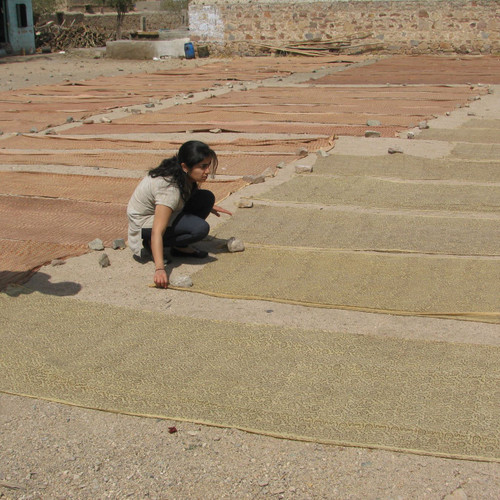Which Material Is Best For Block Printing?
6th Nov 2023
What Is Block Printing?
Block printing is a printmaking technique in which an image is carved into a block of material, and then ink is applied to the block and transferred to paper. Block printing is one of the oldest printmaking techniques, dating back to ancient China. It is a relatively simple technique to learn, and it can be used to create a wide variety of prints, from simple geometric designs to complex landscapes.
Brief History Of Block Printing
Block printing is thought to have originated in China in the 6th century AD. It was used to print Buddhist texts and images on scrolls and banners. Block printing also spread to Japan and Korea, where it was used to print books and other materials. In the 15th century, block printing was introduced to Europe, and it was used to print books, maps, and other items.
Different types of block printing
There are two main types of block printing: relief printing and intaglio printing.
- Relief printing is the most common type of block printing. In relief printing, the image is carved into the block, and the raised areas of the block are inked and transferred to paper.
- Intaglio printing is less common than relief printing. In intaglio printing, the image is carved into the block, and the ink is applied to the recessed areas of the block. The block is then wiped clean, and the paper is pressed onto the block to transfer the ink.
Benefits of block printing
There are many benefits to block printing, including:
- Versatility: Block printing can be used to create a wide variety of prints, from simple to complex.
- Accessibility: Block printing is a relatively inexpensive and accessible printmaking technique.
- Creativity: Block printing is a great way to express your creativity and experiment with different designs and techniques.
- Relaxation: Block printing can be a relaxing and meditative activity.
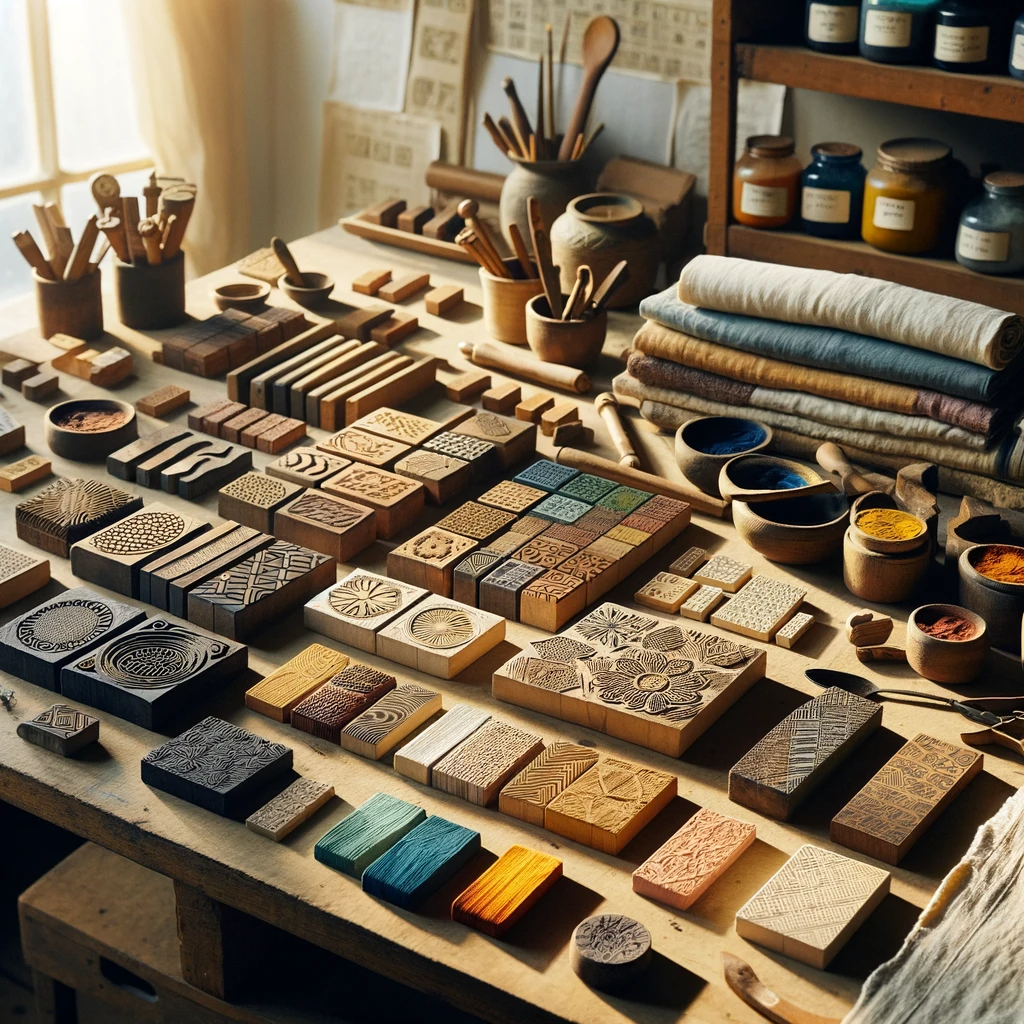
Which material is the best for block printing?
The best material for https://www.ichcha.com/block-print-tablecloths/depends on a number of factors, including the type of print you want to create, your skill level, and your budget. Some of the most common materials used for block printing include:
- Wood: Wood is a classic material for block printing. It is durable and can be used to create a wide variety of prints. However, wood can be difficult to carve, especially if you are a beginner.
- Linoleum: Linoleum is a softer material than wood, and it is easier to carve. Linoleum is also relatively inexpensive. However, linoleum is not as durable as wood, and it may not be suitable for all types of prints.
- Foam: Foam is the easiest material to carve for block printing. It is also very inexpensive. However, foam is not as durable as wood or linoleum, and it may not be suitable for all types of prints.
Factors to consider when choosing the best material for block printing
When choosing a material for block printing, there are a few factors to consider:
- Type of print: The type of print you want to create will determine the best material to use. For example, if you want to create a detailed print with fine lines, you may want to use wood or linoleum. If you want to create a simpler print with bolder lines, you may want to use foam.
- Skill level: If you are a beginner, you may want to start with a softer material, such as linoleum or foam. Wood can be more difficult to carve, especially if you are not used to it.
- Budget: The cost of the material is another factor to consider. Wood is the most expensive material, followed by linoleum and foam.
https://www.ichcha.com/block-print-tablecloths/is a versatile and rewarding printmaking technique. It is a great way to express your creativity and experiment with different designs and techniques. The best material for block printing depends on a number of factors, including the type of print you want to create, your skill level, and your budget.
Different Types of Block Printing
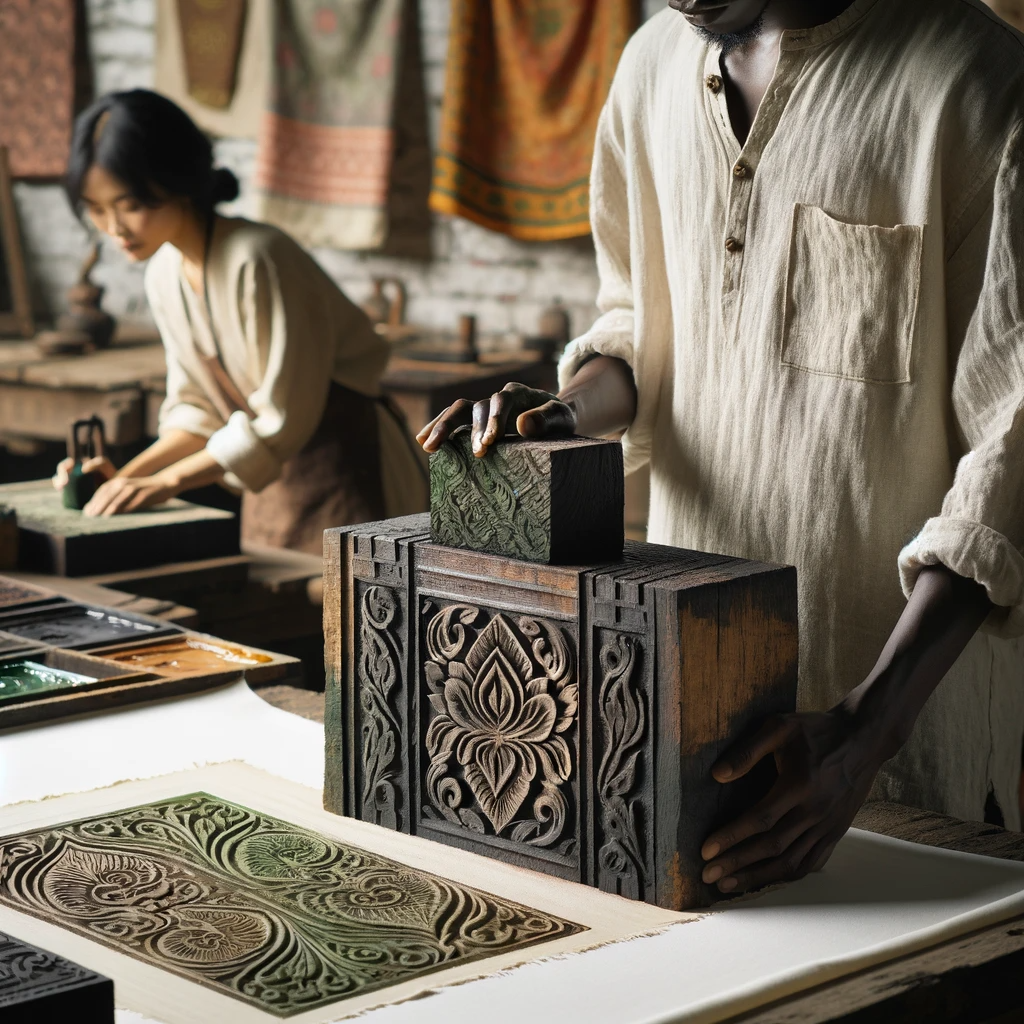
Wood block printing is a type of relief printing that involves carving a design into a block of wood and then inking the block and transferring the design to paper. Woodblock printing is one of the oldest printmaking techniques, dating back to ancient China. It is a versatile technique that can be used to create a wide variety of prints, from simple geometric designs to complex landscapes.
Pros of woodblock printing:
- Wood is a durable material that can be used to create prints that last for many years.
- Wood can be carved to create a wide variety of effects, from fine lines to bold textures.
- Woodblock printing is a relatively inexpensive and accessible printmaking technique.
- Woodblock printing can be a relaxing and meditative activity.
Cons of woodblock printing:
- Wood can be difficult to carve, especially for beginners.
- Wood can be prone to splitting and cracking, especially if it is not properly dried and seasoned.
- Woodblock printing can be a time-consuming process, especially for complex designs.
Different types of wood used for block printing:
- Basswood: Basswood is a soft, easy-to-carve wood that is popular for woodblock printing.
- Birch: Birch is another soft, easy-to-carve wood that is good for woodblock printing.
- Plywood: Plywood is a relatively inexpensive and durable wood that is good for woodblock printing.
- MDF: MDF is a type of engineered wood that is smooth and easy to carve. It is a good choice for woodblock printing, but it is important to note that it is not as durable as other types of wood.
How to prepare wood for block printing:
- Choose a block of wood that is the right size and thickness for your print.
- Sand the wood smooth on all sides.
- Apply a thin coat of gesso to the wood. This will help the ink to adhere to the wood and prevent it from bleeding into the grain.
- Allow the gesso to dry completely before carving your design.
Tips for carving wooden blocks:
- Use a variety of carving tools to create different effects.
- Start with a shallow cut and gradually deepen the cut as needed.
- Be careful not to over-carve the wood, as this can weaken the block and make it more likely to split or crack.
- If you are carving a complex design, it is helpful to draw the design on the wood with a pencil before you start carving.
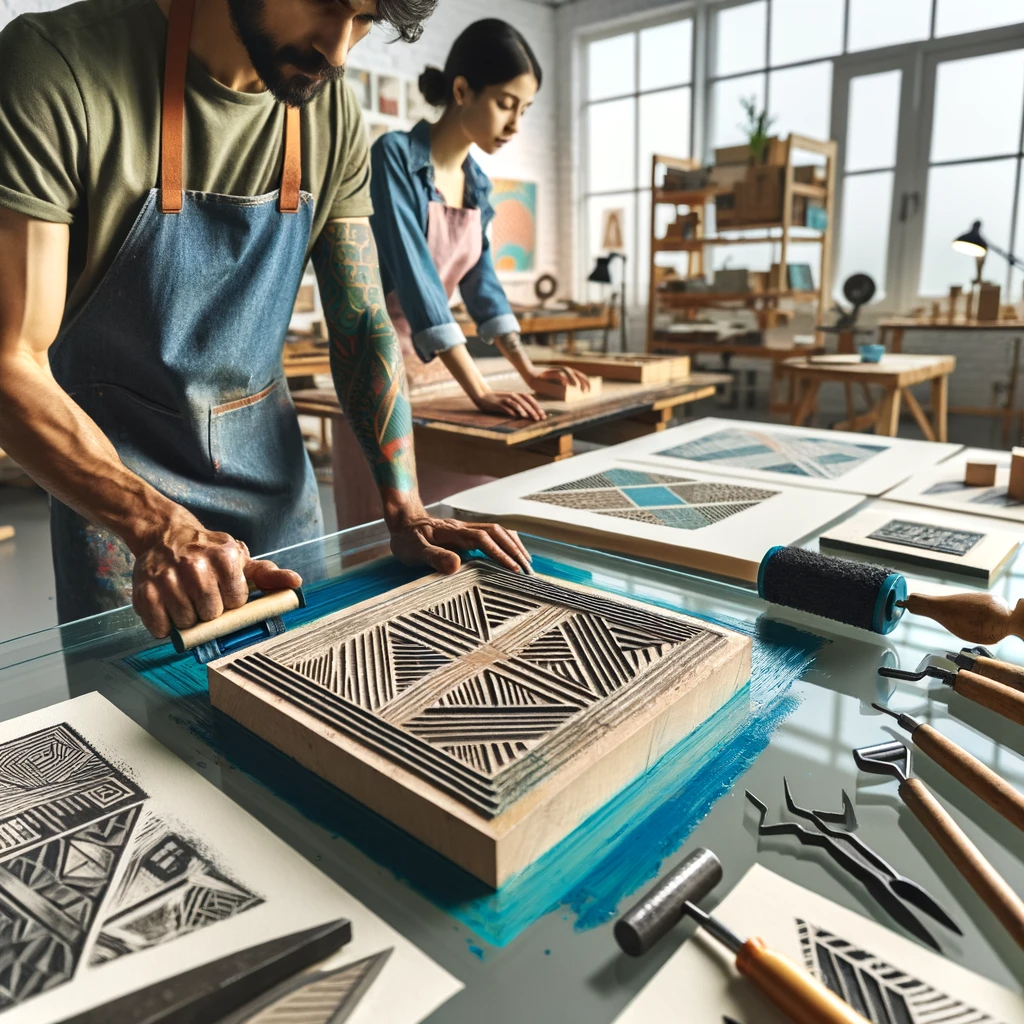
Linoleum block printing is a type of relief printing that involves carving a design into a block of linoleum and then inking the block and transferring the design to paper. Linoleum block printing is a relatively inexpensive and easy-to-learn printmaking technique, making it a popular choice for beginners and experienced artists alike.
Pros of linoleum block printing:
- Linoleum is a soft and easy-to-carve material, making it a good choice for beginners.
- Linoleum is relatively inexpensive and widely available.
- Linoleum is a durable material that can be used to create prints that last for many years.
- Linoleum block printing is a versatile technique that can be used to create a wide variety of prints, from simple geometric designs to complex landscapes.
Cons of linoleum block printing:
- Linoleum can be prone to warping, especially if it is not properly stored.
- Linoleum block printing can be a time-consuming process, especially for complex designs.
Different types of linoleum used for block printing:
- Battleship linoleum: Battleship linoleum is the most durable type of linoleum, and it is the best choice for creating prints that will be used multiple times.
- Soft-cut linoleum: Soft-cut linoleum is a softer and easier-to-carve type of linoleum. It is a good choice for beginners and for artists who want to create prints with fine lines and details.
- Rubber linoleum: Rubber linoleum is a synthetic type of linoleum that is very soft and easy to carve. It is a good choice for beginners and for artists who want to create prints with a lot of detail.
How to prepare linoleum for block printing:
- Choose a block of linoleum that is the right size and thickness for your print.
- If the linoleum is warped, you can flatten it by placing it under a heavy book or by pressing it with a rolling pin.
- Apply a thin coat of gesso to the linoleum. This will help the ink to adhere to the linoleum and prevent it from bleeding into the grain.
- Allow the gesso to dry completely before carving your design.
Tips for carving linoleum blocks:
- Use a variety of carving tools to create different effects.
- Start with a shallow cut and gradually deepen the cut as needed.
- Be careful not to over-carve the linoleum, as this can weaken the block and make it more likely to tear.
- If you are carving a complex design, it is helpful to draw the design on the linoleum with a pencil before you start carving.
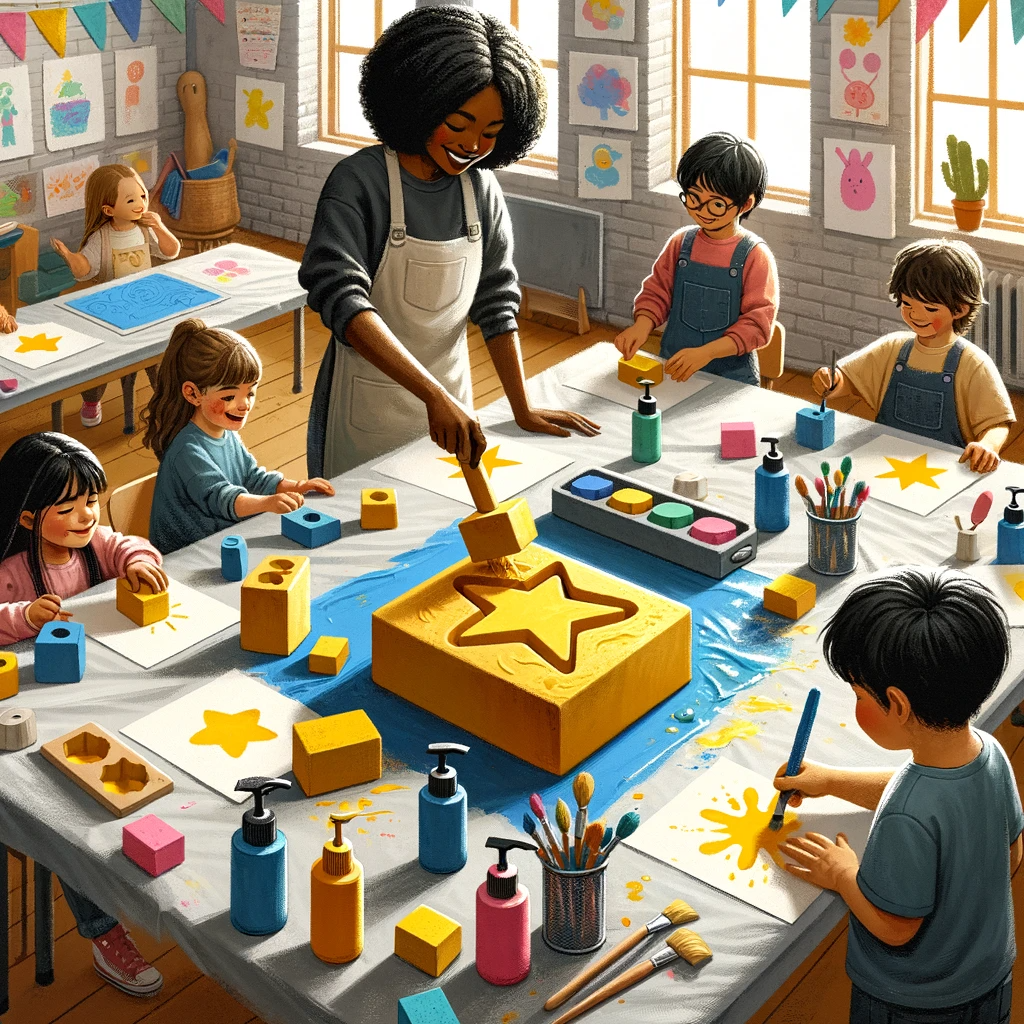
Foam block printing is a type of relief printing that involves carving a design into a block of foam and then inking the block and transferring the design to paper. Foam block printing is the easiest type of block printing to learn, and it is a great way to start with block printing.
Pros of foam block printing:
- Foam is a soft and easy-to-carve material, making it a good choice for beginners.
- Foam is very inexpensive and widely available.
- Foam block printing is a quick and easy process, making it a good choice for creating prints for special occasions or for children's projects.
Cons of foam block printing:
- Foam is not as durable as wood or linoleum, and it may not be suitable for all types of prints.
- Foam can be difficult to carve fine lines and details.
Different types of foam used for block printing:
- Craft foam: Craft foam is the most common type of foam used for block printing. It is inexpensive and easy to find at craft stores.
- EVA foam: EVA foam is a denser type of foam that is more durable than craft foam. It is a good choice for prints that will be used multiple times.
- Styrofoam: Styrofoam is a lightweight and inexpensive type of foam. However, it is not as durable as craft foam or EVA foam, and it can be difficult to carve fine lines and details.
How to prepare foam for block printing:
- Choose a block of foam that is the right size and thickness for your print.
- Cut the foam to the desired size.
- Use a piece of sandpaper to smooth the edges of the foam.
- Apply a thin coat of gesso to the foam. This will help the ink to adhere to the foam and prevent it from bleeding into the grain.
- Allow the gesso to dry completely before carving your design.
Tips for carving foam blocks:
- Use a variety of carving tools to create different effects.
- Start with a shallow cut and gradually deepen the cut as needed.
- Be careful not to over-carve the foam, as this can destroy the block.
- If you are carving a complex design, it is helpful to draw the design on the foam with a pencil before you start carving.
Once you have carved your design, you are ready to ink the block and print your design. There are many different ways to ink a foam block, but the most common method is to use a brayer. A brayer is a roller that is used to apply ink to the block.
To print your design, simply place a piece of paper on top of the inked block and press down firmly. You can use a variety of different materials to press the paper onto the block, such as a spoon, a rolling pin, or a printing press.
Foam block printing is a fun and easy way to create unique prints. With a little practice, you can create beautiful prints for a variety of occasions.
Here are some additional tips for foam block printing:
- Use water-based inks for foam block printing. Oil-based inks can damage the foam.
- If you are using craft foam, be sure to choose a type of foam that is specifically designed for block printing. Some types of craft foam can be difficult to carve and may not produce good results.
- If you are carving a complex design, consider using a stencil to help you. Stencils can be purchased at craft stores or made at home.
- If you are printing on fabric, be sure to use a fabric ink. Fabric inks are designed to bond with fabric and will not wash out.
Foam block printing is a great way to experiment with different printing techniques and to create unique and personalized prints.

Conclusion
There are three main materials used for block printing: wood, linoleum, and foam.
Wood is the most durable material for block printing, and it can be used to create prints that last for many years. However, wood can be difficult to carve, especially for beginners.
Linoleum is a softer and easier-to-carve material than wood. It is also relatively inexpensive and widely available. Linoleum is a good choice for beginners and for artists who want to create prints with fine lines and details.
Foam is the easiest type of material to carve for block printing. It is also very inexpensive and widely available. Foam is a good choice for beginners and for artists who want to create prints for special occasions or Cfor children's projects.
Which material is the best for block printing?
The best material for block printing depends on your skill level, budget, and the type of prints you want to create. If you are a beginner, I recommend starting with linoleum or foam. These materials are easy to carve and relatively inexpensive. If you are an experienced artist and want to create detailed prints, I recommend wood.

